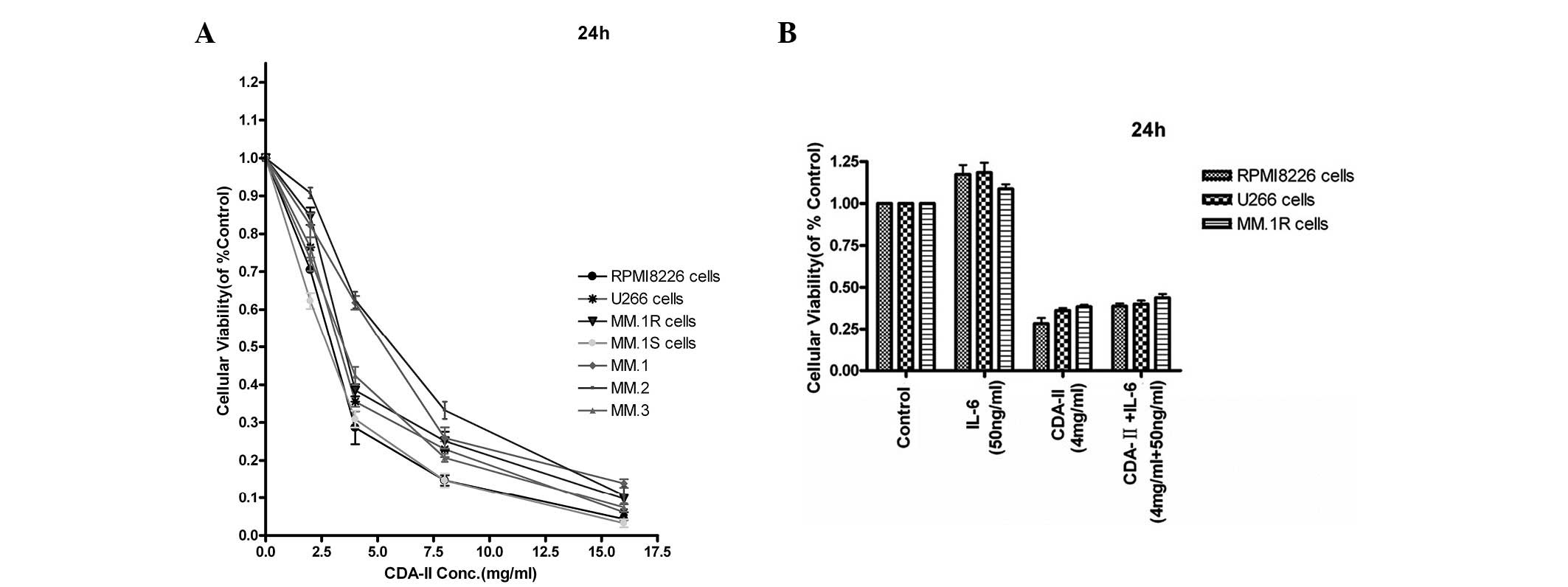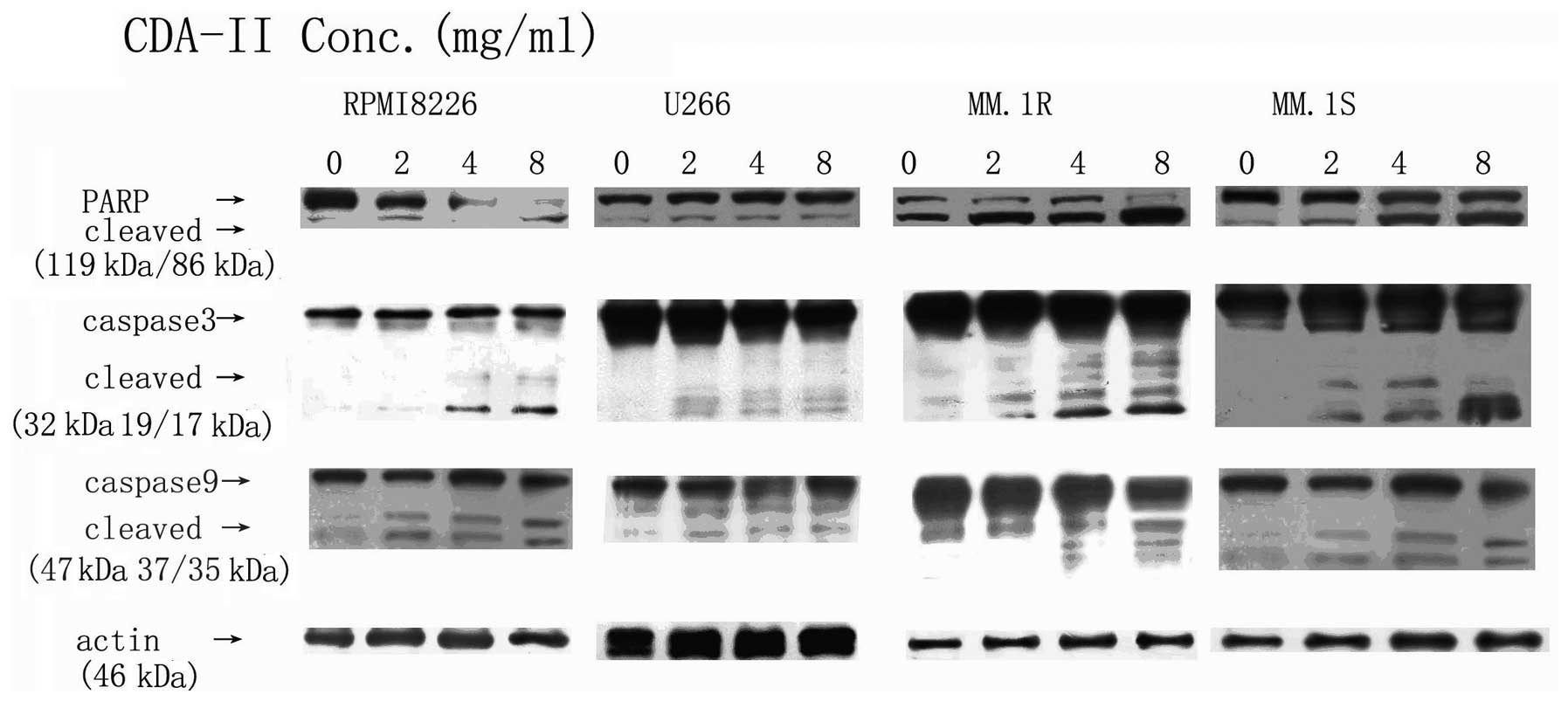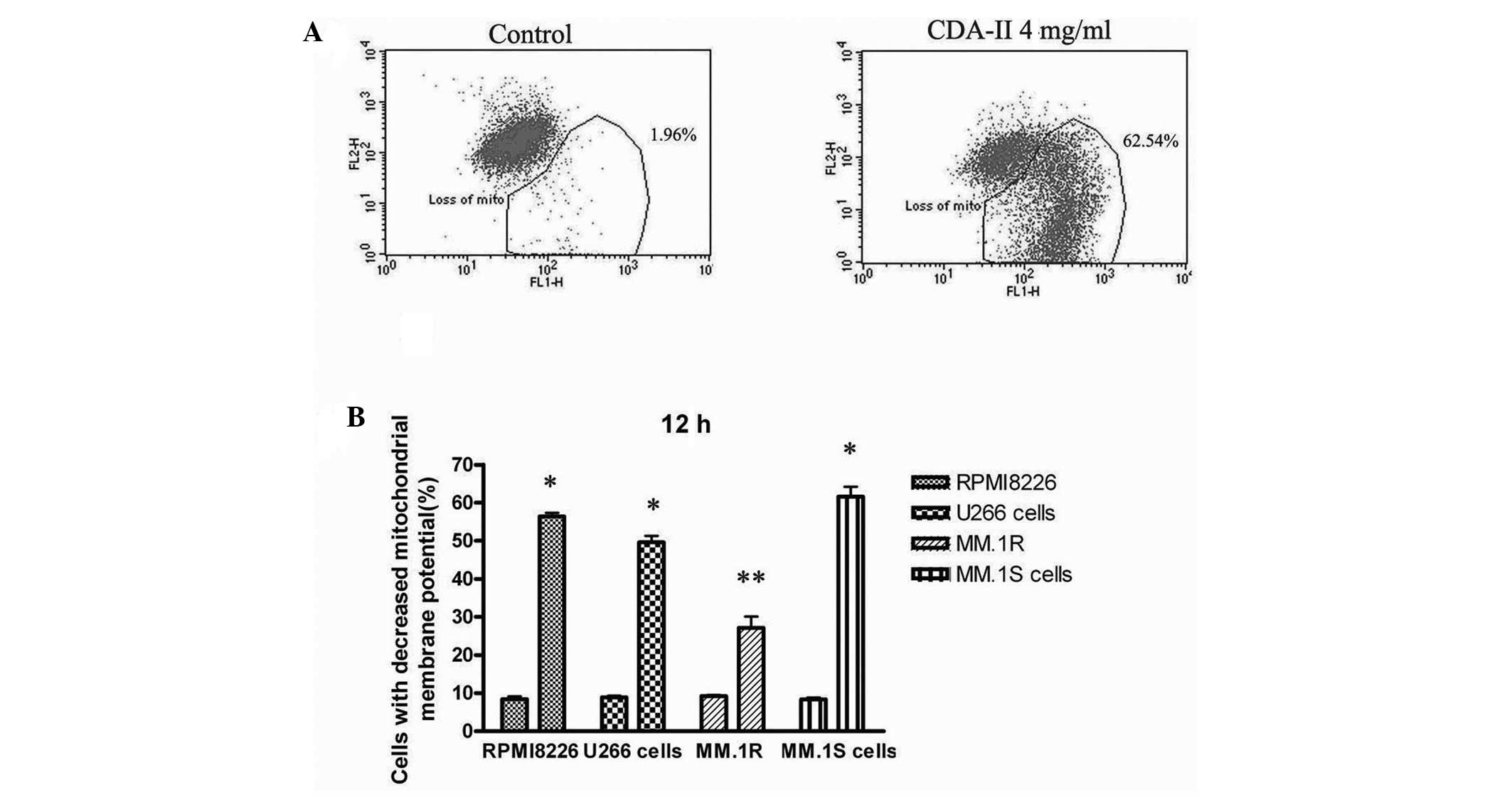|
1
|
Gregory WM, Richards MA and Malpas JS:
Combination chemotherapy versus melphalan and prednisolone in the
treatment of multiple myeloma: an overview of published trials. J
Clin Oncol. 10:334–342. 1992.PubMed/NCBI
|
|
2
|
Lenhoff S, Hjorth M, Holmberg E, et al:
Impact on survival of high-dose therapy with autologous stem cell
support in patients younger than 60 years with newly diagnosed
multiple myeloma: a population-based study. Nordic Myeloma Study
Group. Blood. 95:7–11. 2000.PubMed/NCBI
|
|
3
|
Attal M, Harousseau JL, Facon T, et al;
InterGroupe Francophone du Myélome. Single versus double autologous
stem-cell transplantation for multiple myeloma. N Engl J Med.
349:2495–2502. 2003. View Article : Google Scholar : PubMed/NCBI
|
|
4
|
Sonneveld P: Drug resistance in multiple
myeloma. Pathol Biol (Paris). 47:182–187. 1999.PubMed/NCBI
|
|
5
|
Covelli A: Modulation of multidrug
resistance (MDR) in hematological malignancies. Ann Oncol. 10(Suppl
6): 53–59. 1999. View Article : Google Scholar : PubMed/NCBI
|
|
6
|
Schwarzenbach H: Expression of
MDR1/P-glycoprotein, the multidrug resistance protein MRP, and the
lung-resistance protein LRP in multiple myeloma. Med Oncol.
19:87–104. 2002. View Article : Google Scholar : PubMed/NCBI
|
|
7
|
Burzynski SR: Antineoplastons: history of
the research (I). Drugs Exp Clin Res. 12(Suppl 1): 1–9. 1986.
|
|
8
|
Badria F, Mabed M, Khafagy W and Abou-Zeid
L: Potential utility of antineoplaston A-10 levels in breast
cancer. Cancer Lett. 155:67–70. 2000. View Article : Google Scholar : PubMed/NCBI
|
|
9
|
Lin WC, Wu YW, Lai TY and Liau MC: Effect
of CDA-II, urinary preparation, on lipofuscin, lipid peroxidation
and antioxidant systems in young and middle-aged rat brain. Am J
Chin Med. 29:91–99. 2001. View Article : Google Scholar : PubMed/NCBI
|
|
10
|
Masood R, McGarvey ME, Zheng T, Cai J,
Arora N, Smith DL, Sloane N and Gill PS: Antineoplastic urinary
protein inhibits Kaposi’s sarcoma and angiogenesis in vitro and in
vivo. Blood. 93:1038–1044. 1999.
|
|
11
|
Yao CJ, Lai GM, Chan CF, Yang YY, Liu FC
and Chuang SE: Differentiation of pheochromocytoma PC12 cells
induced by human urine extract and the involvement of the
extracellular signal-regulated kinase signaling pathway. J Altern
Complement Med. 11:903–908. 2005. View Article : Google Scholar : PubMed/NCBI
|
|
12
|
Liau MC, Szopa M, Burzynski B and
Burzynski SR: Quantitative assay of plasma and urinary peptides as
an aid for the evaluation of cancer patients undergoing
antineoplaston therapy. Drugs Exp Clin Res. 13(Suppl 1): 61–70.
1987.PubMed/NCBI
|
|
13
|
Sun JJ, Zhou Xd and Liu YK: Effect of
CDA-II on prevention and therapy for metastasis and recurrence of
liver cancer in nude mice. Chin J Hepatobiliary Surg. 546–551.
2006.(In Chinese).
|
|
14
|
Sun L, Huang Q, Wang A, Lan Q, Du Z and Hu
G: cDNA array in the establishment of a gene expression profile
associated with differentiation inducing the glioma cells. Zhonghua
Zhong Liu Za Zhi. 24:222–225. 2002.(In Chinese).
|
|
15
|
Wang YH and Zheng WI: Effects of
uroacitides on proliferation ability of breast cancer cells.
Chinese Journal of Clinical Pharmacology and Therapeutics.
10:677–681. 1999.(In Chinese).
|
|
16
|
Lin WC, Liao YC, Liau MC, Lii CK and Sheen
LY: Inhibitory effect of CDA-II, a urinary preparation, on
aflatoxin B(1)-induced oxidative stress and DNA damage in primary
cultured rat hepatocytes. Food Chem Toxicol. 44:546–551. 2006.
View Article : Google Scholar : PubMed/NCBI
|
|
17
|
Chen Z, Jin G, Lin S, Lin X, Gu Y, Zhu Y,
Hu C, Zhang Q, Wu L and Shen H: DNA methyltransferase inhibitor
CDA-II inhibits myogenic differentiation. Biochem Biophys Res
Commun. 422:522–526. 2012. View Article : Google Scholar : PubMed/NCBI
|
|
18
|
Huang J, Yang M, Liu H and Jin J: Human
urine extract CDA-2 induces apoptosis of myelodysplastic
syndrome-derived MUTZ-1 cells through the PI3K/Akt signaling
pathway in a caspase-3-dependent manner. Acta Pharmacol Sin.
29:951–964. 2008. View Article : Google Scholar : PubMed/NCBI
|
|
19
|
Fischer U and Schulze-Osthoff K:
Apoptosis-based therapies and drug targets. Cell Death Differ.
12(Suppl 1): 942–961. 2005. View Article : Google Scholar
|
|
20
|
Carter BZ, Mak DH, Schober WD, McQueen T,
Harris D, Estrov Z, Evans RL and Andreeff M: Triptolide induces
caspase-dependent cell death mediated via the mitochondrial pathway
in leukemic cells. Blood. 108:630–637. 2006. View Article : Google Scholar : PubMed/NCBI
|
|
21
|
Burzynski SR: The present state of
antineoplaston research (1). Integr Cancer Ther. 3:47–58. 2004.
View Article : Google Scholar : PubMed/NCBI
|
|
22
|
Hehir KM, Baguisi A, Pennington SE, Bates
JM and DiTullio PA: A potential antitumor peptide therapeutic
derived from antineoplastic urinary protein. Peptides. 25:543–549.
2004. View Article : Google Scholar : PubMed/NCBI
|
|
23
|
Lakhani NJ, Sparreboom A, Xu X, Veenstra
TD, Venitz J, Dahut WL and Figg WD: Characterization of in vitro
and in vivo metabolic pathways of the investigational anticancer
agent, 2-methoxyestradiol. J Pharm Sci. 96:1821–1831. 2007.
View Article : Google Scholar : PubMed/NCBI
|
|
24
|
Linder-Stragliotto C, Strander H,
Munck-Wikland E and Sten-Linder M: Low levels of endostatin in the
urine from patients with malignant disease. Tumour Biol.
23:222–227. 2002. View Article : Google Scholar : PubMed/NCBI
|
|
25
|
Huang J, Yang M, Liu H and Jin J: CDA-II,
a urinary preparation, induces growth arrest and apoptosis of human
leukemia cells through inactivation of nuclear factor-kappaB in a
caspase-dependent manner. Food Chem Toxicol. 47:40–49. 2009.
View Article : Google Scholar
|
|
26
|
Zhang B, Gojo I and Fenton RG: Myeloid
cell factor-1 is a critical survival factor for multiple myeloma.
Blood. 99:1885–1893. 2002. View Article : Google Scholar : PubMed/NCBI
|
|
27
|
Tu Y, Renner S, Xu F, et al: BCL-X
expression in multiple myeloma: possible indicator of
chemoresistance. Cancer Res. 58:256–262. 1998.PubMed/NCBI
|
|
28
|
Bharti AC, Shishodia S, Reuben JM, et al:
Nuclear factor-kappaB and STAT3 are constitutively active in
CD138+ cells derived from multiple myeloma patients, and
suppression of these transcription factors leads to apoptosis.
Blood. 103:3175–3184. 2004.PubMed/NCBI
|
|
29
|
Gomez-Bougie P, Wuillème-Toumi S, Ménoret
E, Trichet V, Robillard N, Philippe M, Bataille R and Amiot M: Noxa
up-regulation and Mcl-1 cleavage are associated to apoptosis
induction by bortezomib in multiple myeloma. Cancer Res.
67:5418–5424. 2007. View Article : Google Scholar : PubMed/NCBI
|
|
30
|
Han J, Goldstein LA, Gastman BR and
Rabinowich H: Interrelated roles for Mcl-1 and BIM in regulation of
TRAIL-mediated mitochondrial apoptosis. J Biol Chem.
281:10153–10163. 2006. View Article : Google Scholar : PubMed/NCBI
|
|
31
|
Podar K, Gouill SL, Zhang J, Opferman JT,
Zorn E, Tai YT, Hideshima T, Amiot M, Chauhan D, Harousseau JL and
Anderson KC: A pivotal role for Mcl-1 in Bortezomib-induced
apoptosis. Oncogene. 27:721–731. 2008. View Article : Google Scholar : PubMed/NCBI
|
|
32
|
Nakagawa Y, Abe S, Kurata M, Hasegawa M,
Yamamoto K, Inoue M, Takemura T, Suzuki K and Kitagawa M: IAP
family protein expression correlates with poor outcome of multiple
myeloma patients in association with chemotherapy-induced
overexpression of multidrug resistance genes. Am J Hematol.
81:824–831. 2006. View Article : Google Scholar
|
|
33
|
Spets H, Strömberg T, Georgii-Hemming P,
Siljason J, Nilsson K and Jernberg-Wiklund H: Expression of the
bcl-2 family of pro- and anti-apoptotic genes in multiple myeloma
and normal plasma cells: regulation during
interleukin-6(IL-6)-induced growth and survival. Eur J Haematol.
69:76–89. 2002. View Article : Google Scholar : PubMed/NCBI
|















